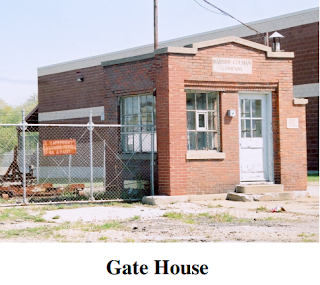Lost Illinois Manufacturing
posted a video that walks through the abandoned factories. I didn't watch the video itself, but the comments provided a nice history of the complex. Of note is the phrase "Water Power District." That means there used to be a mill race running from
the dam we still see in the Rock River.
They started in the second story of a building in the Water Power District. But the success of their Hand Knotter and Warp Tying Machine was so great that they started building in a residential district south of Loomis Street between Rock Street and the CN/IC railroad between 1900 and 1952. "Barber-Colman estimated that its textile machines
were used by 90% of the weaving mills in this country. [Rockford Republic, August 9, 1965]." Over the decades they diversified into several other product lines. [Survey]
Irma Dmgz
posted four photos with the comment: "
The Barber–Colman Company. Rockford Illinois."
Al Tilford floors are buckling now.roof is leaking..would take millions to get it turned into anything. such a shame they didn't get on it as soon as the knew it was being left empty to sit...
 |
| 1 |
 |
| 2 |
 |
| 3 |
 |
| 4 |
When they built their first plant, proximity to the streetcar line on Main Street was important. But by 1952 travel by automobile was well established so they bought land north of Clifford Ave. and south of Windsor Road in Loves Park for their additional expansions. Some of those buildings appear to be still used: GE Aviation, Gleason Cutting Tools, etc. Production continued at the original site until 1996. A business incubator used the site until it failed in 1999. Rockford bought the complex in 2002 for $750,000. The satellite image above indicates that not all of the buildings have been torn down. But they evidently still have not found a developer with a viable idea as to how to repurpose the buildings. [Survey,
American Urbex]
The referenced
survey identifies 22 structures that they built at this complex during their expansion, 15 of which still exist and 7 of which are considered architecturally significant. Their loft (multi-story) buildings provide examples of all three phases of design:
- standard mill with wood or cast-iron posts and wood beams
- reinforced concrete using post and beams
- reinforced concrete using mushroom columns and flat slab floors
Steven Abbott
posted two photos with the comment: "
Barber Colman company was once a thriving factory but has been shut down for years in Rockford, IL."
Bob Rever Again a city owned property. Broken windows, condemned, and left in disrepair.
 |
| 1 |
 |
| 2 |
David Charles Lindberg
posted six photos with the comment:
The huge former Barber Coleman complex in Southwest Rockford. During it height in the 60's it employed over 2,500 people at this site. Rockford was once the Tool and Dye Capital of the wold and had many very large manufacturing plants, but as time went by they were purchased by national companies and down sized or were moved south where cheaper labor was available. The long recession of the early 80's also took its toll as many of them closed their doors for good. I've been trying to document these former thriving plants and buildings before they are gone for good.
Bob Rever Now it’s owned by the city, full of broken windows, condemned, and rotting. Imagine the fines if it were privately owned.
Briana Hamilton I went in there years ago before the city bought it. Very impressive, even in its rotting state. It had tunnels, but most are collapsed now. We only found one that wasn't, and the guys with me couldn't travel down it for long before it got too tight. My mom was working in one of the buildings in the 80s when she was pregnant with my brother.
Connie Ashmun Thanks for the interest and the effort- there are so many fantastic, decaying reminders of the heights to which Rockford soared, and the current depths. I'm glad someone is documenting the collapses.
David Charles Lindberg Connie Ashmun Thanks. I've lived in Rockford all my life, except for four years in San Diego. I'm old enough to remember all of the manufacturing plants and the well paying jobs they provided. My father and Grand father retired from Rockford Screw Products. I think it's important that these abandon plants are remembered because they were the back bone of our community for many decades.
Randy Hoepker What a place! Reminds me of the IH plant in Canton. [I need to reseaqrch IH in Canton.]
Paul Lindstrom I have cousins who grew up in Rockford and one still lives there. I have driven through the inner city several times and seen literally the acres and acres of closed factories. It seems highly ironic that in the 1930s my uncle migrated there for a better life and actually succeeded.
 |
| 1 |
 |
| 2 |
 |
| 3 |
 |
| 4 |
 |
| 5 |
 |
| 6 |
Luke Swanborg
posted three photos.
 |
| 1 |
 |
| 2 |
 |
| 3 |
 |
| Screenshot from Page 23 of Survey |
The site also includes factories with various roof lines including saw-tooth roofs and industrial garages including one with bow-string trusses. It has a powerhouse with two smoke stacks and a gate house that has had few alterations.

















No comments:
Post a Comment